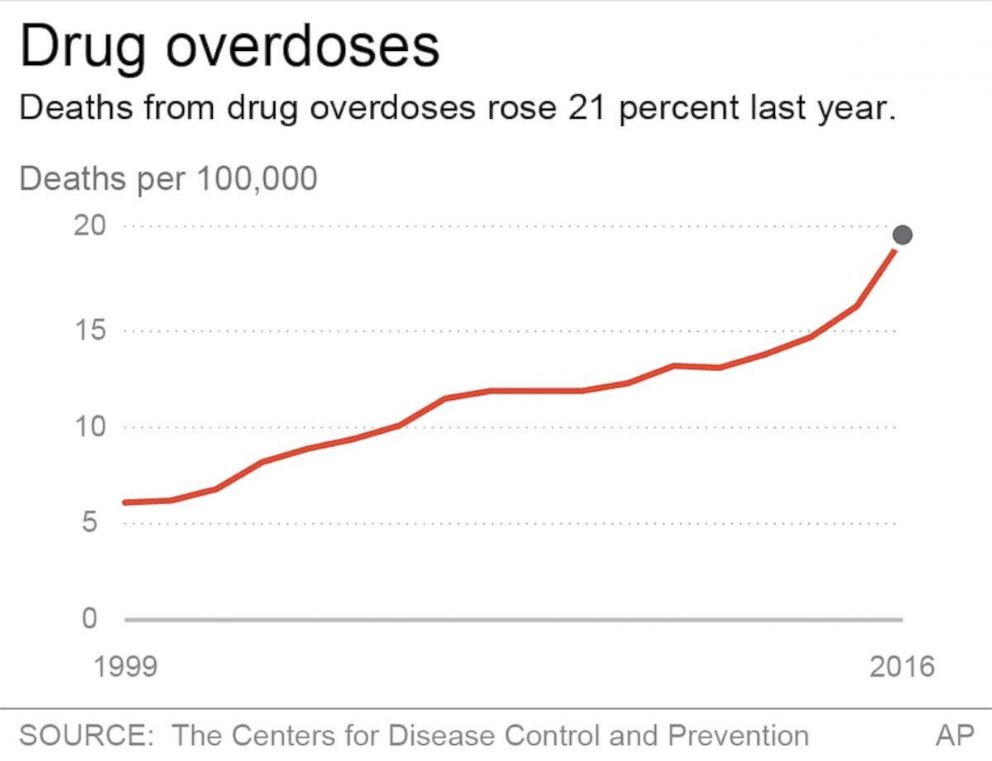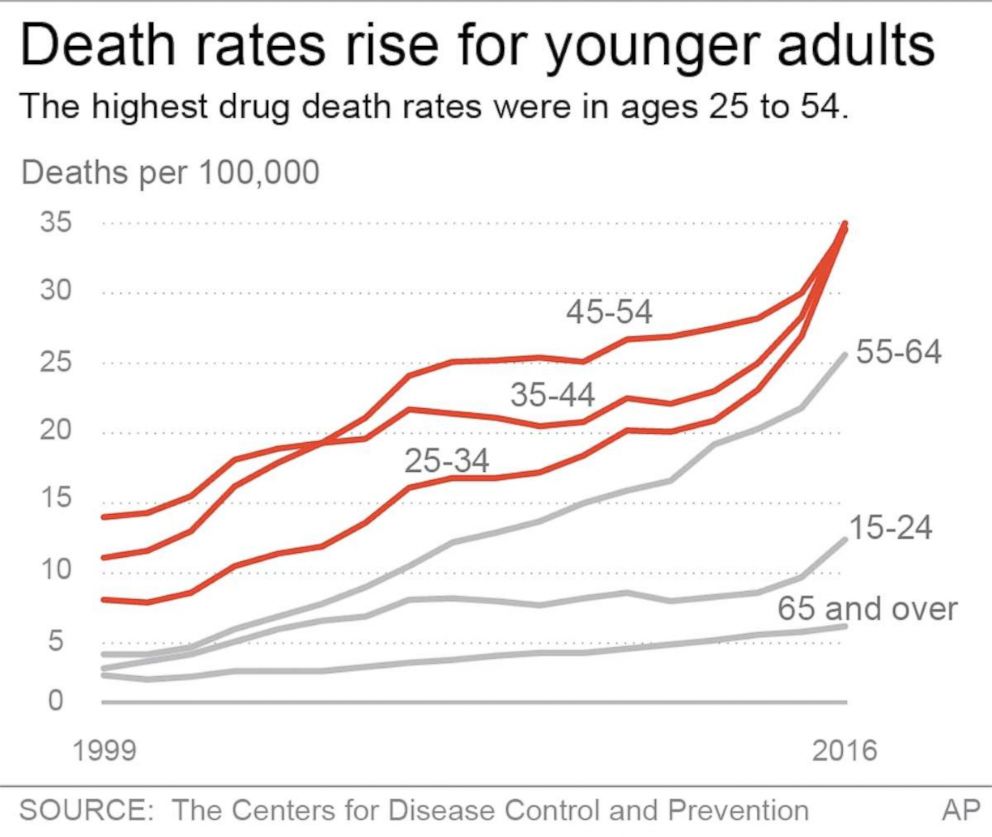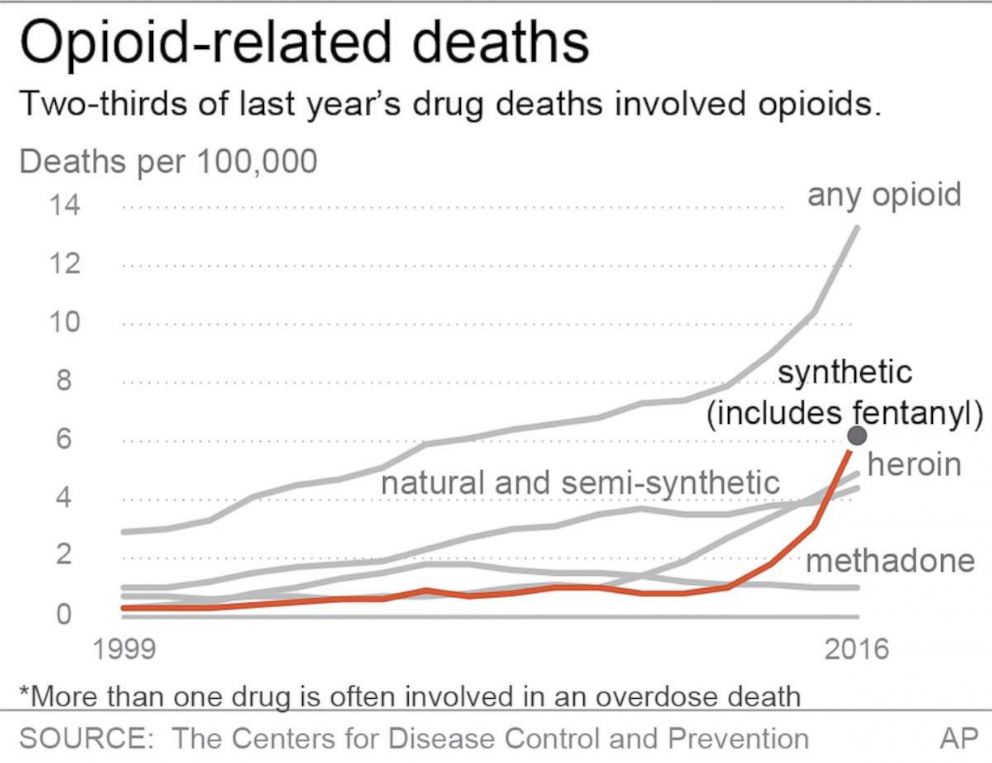Drug overdose deaths drive US life expectancy down for second year
American life expectancy is now 78.6 years, down by 0.1 years from 2015.
— -- Life expectancy in the U.S. decreased for the second year in a row in 2016, largely because of rising drug overdose deaths in younger Americans, the CDC said.
American life expectancy is now 78.6 years, down by 0.1 years from 2015 and also down from 2014, according to new data released Thursday by the CDC’s National Center for Health Statistics.
The last time life expectancy decreased for two years in a row was 1963.

The decline in life expectancy appears to be caused by rising death rates for Americans ages 15-64. Death rates of Americans ages 25-34 by 10.5 percent between 2015 and 2016, and other young age groups also have increased death rates.
“It seems to be driven by the increase in drug overdose death,” Bob Anderson, chief of the mortality statistics branch at the CDC told ABC News. “This is the key factor.”
Anderson noted the “dramatic rise in drug overdose deaths,” a 30 percent spike between 2015 and 2016, among young adults.

Overall, more than 63,600 people in the U.S. died from drug overdose in 2016, up from about 52,400 in 2015.
But, experts say the picture may be even worse than it seems.
“In some ways, this is a total underestimate of the death and disability caused by drugs because it is just overdose death,” said Cleveland Clinic addiction specialist Dr. David Streem, who was not involved with the report. “We are seeing a lot of body infections, particularly heart infections, that are extremely lethal and related to opioid injection.”
Heart disease and cancer –- the number one and number two top killers of Americans, respectively –- are actually claiming fewer lives, making the drop in life expectancy all the more alarming.
Unintentional drug overdose deaths, which Anderson said are about 86 percent of drug overdoses, are categorized under “unintentional injuries” –- a category that has become the third-leading cause of death in the U.S.
Synthetic opioids, such a fentanyl and similar drugs, appear to be involved in many of these overdoses. Deaths from synthetic opioids have risen a startling 88 percent per year from 2013 to 2016. Anderson said most of the fentanyl-related deaths are from illegally manufactured fentanyl, rather than pharmaceuticals.
Deaths related to heroin and semi-synthetic opioids, such as oxycodone and hydrocodone, have also increased.
Drug combinations are responsible for many drug overdose deaths, Anderson and Streem both noted. Fentanyl is frequently combined with heroin and cocaine in street drug formulations.
According to the new report, drug-overdose deaths were highest in West Virginia, Ohio, New Hampshire and Pennsylvania. Though it is not entirely clear why, experts suggest it may be related to drug trafficking patterns, population characteristics, frequency of opioid prescriptions and delayed prescription monitoring systems in these states.

In an effort to combat the opioid epidemic, health care providers, health agencies and officials have enact new policies, but so far none have stemmed the tide of opioid addiction.
Efforts to increase the capabilities of first responders at the scene of the overdose, increase access to treatments and train doctors to appropriately diagnose and treat drug addiction have been made, Streem said.
Limiting the number of opioids prescribed has also been encouraged in CDC guidelines for doctors.
Though the volume of prescription opioids has decreased in recent years, there's some concern that fewer prescribed opioids may push patients towards using heroin and other dangerous unregulated street drug formulations.
Doctors can also monitor how often and from whom patients get their opioid prescriptions through state and national prescription drug databases.
Naloxone, also known as Narcan, can quickly reverse the effects of an opioid overdose and has become more widely available.
Medications to help patients quit opioids, like Suboxone and methadone, provide low potency opioids in a safer formulation, preventing withdrawal. But the number of prescribers is limited and not yet enough for the growing numbers of opioid-addicted patients.
Additionally there may be “missed opportunities” for transitioning patients to these medications, according to addiction specialist Dr. Jeanmarie Perrone, professor of emergency medicine and director of medical toxicology at the University of Pennsylvania.
“We need to initiate the treatment when we have the opportunity,” she said, such as when patients are in the hospital or immediately after an overdose. “We need to meet patients where they are.”
Perrone said that measure like safe injection sites, which allow the opioid-addicted to use in monitored, safe environments -- a controversial practice not commonly adopted in the U.S. -- could save lives.
“We need to quadruple our efforts to help these people,” she said.
Though it’s hard to know with certainty what will happen in the future, Anderson said “2017 doesn’t look good.”
"We may expect to see life expectancy decrease for a third year in a row,” he said, “and we haven’t seen that since the Spanish Flu in 1916, 1917 and 1918.”




